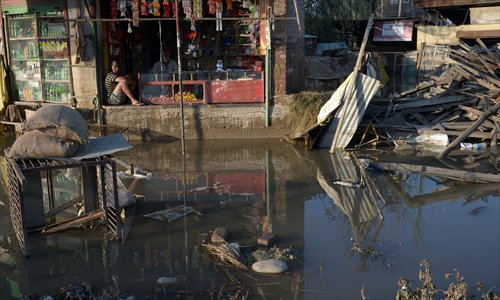The price of indifference
India caught unready for floods

A Kashmiri shopkeeper waits for customers as he sit inside a flood water logged area in Srinagar on Tuesday. Photo: AFP
The massive devastation, in terms of human lives and property, caused by unusually heavy early September downpours in India's Jammu and Kashmir (J&K) region have caused concern due to the floods' strong links with the rapidly changing climate across the Himalayan region.
The worst floods since 1859, which killed over 460 people and stranded more than 1 million in the region around the India-Pakistan border, "could very well be another manifestation of an extreme weather event induced by a changing climate," said New Delhi-based developmental and environmental think-tank Center for Science and Environment (CSE).
Beginning September 3, the state received a massive 250 millimeters rain in three days, out of an average total seasonal monsoon rainfall of 558 millimeters.
Rainfall on the day of September 6 alone was 106 millimeters, "which is unbelievably 3,116 percent of the normal rainfall for that date for J&K," Himanshu Thakkar of South Asia Network on Dams, Rivers and People (SANDRP) told the Global Times.
Unprepared governments
In spite of a history of calamitous floods in the recent past, Jammu and Kashmir has not been included in the flood forecasting and advisory mechanism of the Indian government's Central Water Commission (CWC).
Although VD Roy, CWC's director of flood forecasting told Down to Earth (DTE) correspondent Soma Basu that J&K has a hydrological observatory that shares data with the state government, water issues expert Himanshu Thakkar said the CWC's flood forecast sites provide no hydrographs for J&K.
Roy blames extenuating circumstances for the current lack of flood forecasting stations in J&K. In his interview with Basu, however, he said that, "we plan to extend the centers and soon Jammu and Kashmir will have an additional flood forecast station."
Meanwhile, the government of Jammu and Kashmir hasn't created a separate department with dedicated officials for dealing with disasters even though a three-tier disaster management policy was approved in February 2012 to put in place a proper mechanism for rescue, relief and rehabilitation of disaster victims, Basu quoted a National Disaster Mitigation Authority (NDMA) official as saying.
It's because of such negligence that the governments of India and the state of Jammu and Kashmir have been left unprepared to mitigate disaster risks, while what relief operations there are lack proper official coordination, drawing fierce criticism from aid workers and disaster victims alike.
Indifference toward climate issues
September is J&K's driest month, making it strange that the month saw the worst floods in decades, said climate campaigner Marianna Musset in an online commentary written for a Global Call for Climate Action website, adding, "flash flooding events whilst not uncommon are becoming more extreme and more frequent due to climate change."
Taking her lead from reports of the Intergovernmental Panel on Climate Change (IPCC), Musset noted that "rising temperatures have not only resulted in greater glacial melt, but are also weakening monsoon circulation, resulting in greater precipitation."
"Projections in the region indicate a rise of minimum temperatures in the Himalayan region of 1 C to 4.5 C. Maximum temperatures may rise by 0.5 C to 2.5 C, while precipitation is expected to increase by 1-2 millimeter(s)/day," Musset said, warning that the Kashmir Valley is "extremely vulnerable to climate change and particularly vulnerable to increased flooding."
In spite of these realities, both the central and state governments have remained indifferent to climate issues, pursuing blatantly anti-environmental development agendas.
After compiling a list of weather-induced disasters in India during recent years, CSE researchers said "the scale of disaster in J&K has been exacerbated by unplanned development - especially on the riverbanks. In the last 100 years, more than 50 percent of the lakes, ponds and wetlands of Srinagar (J&K's summer capital) have been encroached upon by building and road construction."
Apart from urbanization, as experts believe, river channelization and large-scale construction activities on the floodplains of the state have resulted in the loss of much of the region's natural flood defenses, leaving it unable to cope with unexpected rises in water levels.
Seeing hydropower projects as another danger to the valley and its environment, Himanshu Thakkar of SANDRP has criticized the Ministry of Environment and Forests (MoEF) of India's clearance of projects in the Chenab basin without proper social and environment impact assessments.
"Such decisions by the [prime minister's Economic Advisory Council] and MoEF are likely to add to the disaster potential in Chenab and other river basins in J&K," Thakkar warns.
High time for action
IPCC Assessment Report analysis suggests that floods and droughts are likely to increase in India, which would possibly get more rainfall during fewer rainy days.
To deal with extreme climate events and the disasters they will likely cause, "the Indian government must discard its ostrich-like policy and get out of its denial mode. We will have to see the linkages between climate change and the events such as those unfolding in J&K. We will have to accept that climate change is going to affect us more and more in the future. We will, therefore, have to start preparing to adapt to the changing climate," said Sunita Narain, director general of CSE, told the Global Times.
"India should start internalizing climate change adaptation in all developmental policies and programs. From building of cities' infrastructure to agriculture and from water supply to energy infrastructure, we will have to make changes to incorporate climate change impacts," Narain adds.
"Kashmir can't afford to not adapt to climate change induced flooding risks," Musset said, suggesting that "the UN Framework Convention on Climate Change Adaptation Fund & Green Climate Fund must provide crucial mechanisms in a world where climate change impacts are a reality and no longer a future threat."